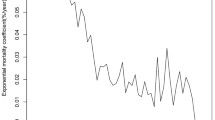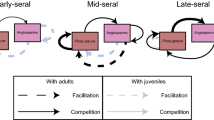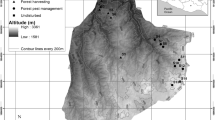Abstract
I examined tree recruitment and mortality over a ten-year period at permanent plots in an urban forest, Forest Park, in Portland, Oregon. The density and diameter at breast height (dbh) for all trees living and dead were measured in 1993 and again in 2003. Data were analyzed using paired Student t-tests. I found significantly fewer live and significantly more dead trees in 2003 than in 1993. The increase in mortality was significant for all species of trees and for all sizes except large diameter trees. Mortality rates ranged from 0% to 67% at my sites. Recruitment was lower at all sites in 2003 with significantly fewer seedlings and saplings. The high mortality and low recruitment resulted in a net loss of trees at all sites. Loss of trees was not offset by increasing tree diameter, which suggests self-thinning is not the cause. No strong correlation with an urban to rural land use gradient was observed. The results may be related to global climate change or pollution. The high mortality of trees of all species in many diameter classes without a concomitant increase in recruitment could lead to dramatic changes in forest structure.





Similar content being viewed by others
References
Acker SA, Franklin JF, Greene SE, Thomas TB, Van Pelt R, Bible KJ (2006) Two decades of stability and change in old-growth forest at Mount Rainier National Park. NW Sci 80:65–72.
Adams HD, Guardiola-Claramonte M, Barron-Gafford GA, Villegas JC, Breshears DD, Zou CB, Trouch PA, Huxman TE (2009) Temperature sensitivity of drought-induced tree mortality portends increased regional die-off under global-change-type drought. Proc Natl Acad Sci USA 106(17):7063–7066
Agee J (1991) Fire history of Douglas-fir forests in the Pacific Northwest. pages 25–33. In: Ruggiero LF, Aubry KB, Carey AB, Huff MH (eds). Wildlife and vegetation of unmanaged Douglas-fir forests. U.S. Dept. of Agric. For. Serv. Pac. NW. Res. Sta. Gen. Tech. Rep. PNW-GTR-285. May 1981. p. 533
Airola T, Buchholz K (1984) Species structure and soil characteristics of five urban forest sites along the New Jersey Palisades. Urban Ecol 8:149–164
Ashby WC, Fritts HC (1972) Tree growth, air pollution, and climate near LaPorte, Indiana. Bull of Amer Meteor Soc 53:246–251
Bagnell RG (1979) A study of human impact on an urban forest remnant: Redwood Bush, Tarva, near Wellington, New Zealand. N Z J Bot 17:117–126
Bertin RI, DeGasperis BG, Sabloff JM (2006) Land use and forest history in an urban sanctuary in Central Massachusetts. Rhodora 108:119–141
Bhuju DR, Ohsawa M (1998) Effects of nature trails on ground vegetation and understory colonization of a patchy remnant forest in an urban domain. Biol Conserv 85:123–135
Bornstein RD (1968) Observations of the urban heat island effect in New York City. J Appl Meteorol 7:575–582
Broshot N (1999) The effects of urbanization and human disturbance upon plant community structure and bird species richness, diversity, and abundance in a natural forested area (Forest Park) in Portland, Oregon. Doctoral Dissertation. Portland State University. Portland, Oregon, p 244
Broshot NE (2007) The influence of urbanization upon forest stand dynamics in Northwestern Oregon. Urban Ecosyst 10:285–298
Busing RT (2005) Tree mortality, canopy turnover, and woody detritus in old cove forests of the Southern Appalachians. Ecol 86:73–84
Campbell S, Smith G, Temple P, Pronos J, Rochefort R, Anderson C (2000) Monitoring for ozone injury in west coast (Oregon, Washington, California) forests in 1998. USDA For Serv Pac NW Res Sta Gen Tech Rep PNW-GTR-495
Carreiro MM, Tripler CE (2005) Forest remnants along urban-rural gradients: examining their potential for global chance research. Ecosyst 8:568–582
Davis L (2004) Urban forestry: engineering cities into natural systems. Page 6 of Virginia Tech Research Magazine. Virginia Tech
DeBell DS, Franklin JF (1987) Old-growth Douglas-fir and western hemlock: a 36-year record of growth and mortality. West J For Res 2(4):111–114
Fahey TJ (1998) Recent changes in an upland forest in south-central New York. J Torrey Bot Soc 125:51–59
Franklin J, Dyrness CT (1988) Natural vegetation of Oregon and Washington. Oregon State University Press, Corvallis, p 452
Franklin J, Spies T (1991) Composition, function, and structure of old-growth Douglas-fir forests. In: Ruggiero LF, Aubry KB, Carey AB, Huff MH (Eds). Wildlife and vegetation of unmanaged Douglas-fir forests. USDA For Ser Pac NW Res Sta, Gen Tech Rep PNW-GTR-285. May 1991, pp 71–80
Franklin J, Shugart HH, Harmon ME (1987) Tree death as an ecological process. Biosci 37:550–556
Gilbertson P, Bradshaw AD (1985) Tree survival in cities: the extent and nature of the problem. Arboricul J 9:131–142
Goldstein AH, McKay M, Kurpius MR, Schade GW, Lee A, Holzinger R, Rasmussen RA (2004) Forest thinning experiment confirms ozone deposition to forest canopy is dominated by reaction with biogenic volatile organic compounds. Geophys Res Lett 31:1–4
Green G (1983) Soil Survey of Multnomah County, Oregon. U. S. Department of Agriculture. Soil Conservation Service and Forest Service. pp 225
Gregg JW, Jones CG, Dawson TE (2003) Urbanization effects on tree growth in the vicinity of New York City. Nature 424:183–187
Gregg JW, Jones CG, Dawson TE (2006) Physiological and developmental effects of O3 on cottonwood growth in urban and rural sites. Ecol Appl 16(6):2368–2381
Greller AM (1975) Persisting natural vegetation in Northern Queens County, New York, with proposals for its conservation. Env Cons 2:61–69
Guarín A, Taylor AH (2005) Drought triggered tree mortality in mixed conifer forests in Yosemite National Park, California, USA. For Ecol Manage 218:229–244
Houle M (1996) One city’s wilderness: Portland’s forest park. The Oregon Historical Society Press, Portland, p 151
Iakovoglou V, Thompson J, Burras L, Kepper R (2001) Factors related to tree growth across urban-rural gradients in the Midwest, USA. Urban Ecosyst 5:71–85
James TDW, Smith DW, Mackintosh EE, Hoffman MK, Mont P (1979) Effects of camping recreation on soil, Jack pine, and understory vegetation in a Northwest Ontario park. For Sci 25:333–349
JMP. (2005) Statistics and graphics guide for jmp. SAS Institute
Johnson R, Wicher D (1982) Applied multivariate statistical analysis. Prentice-Hall, Inc, Englewood Cliffs, p 594
Kim HH (1992) Urban heat island. Intern J Remote Sens 13:2319–2336
Kinnee E, Geron C, Pierce T (1997) United States land use inventory for estimating biogenic ozone precursor emissions. Ecol Appl 7(1):46–58
Komuro T, Koike F (2005) Colonization by woody plants in fragmented habitats of a suburban landscape. Ecol Appl 15:662–673
Kowarik I (1990) Some responses of flora and vegetation to urbanization in Central Europe. pages 45–74. In: Sukopp H, Hejny S (eds) Urban ecology. Plants and plant communities in urban environments. SPB Academic Publ., The Hague, p 282
Leak W, Smith M (1996) Sixty years of management and disturbance in a New England forested landscape. For Ecol Manag 81:63–73
Lehvävirta S, Hannu R (2002) Natural regeneration of trees in urban woodlands. J Veg Sci 13:57–66
Littlemore J, Barker S (2001) The ecological response of forest ground flora and soils to experimental trampling in British urban woodlands. Urban Ecosyst 5:257–276
Lorimer CG, Dahia SE, Nordheim EL (2001) Tree mortality rates and longevity in mature and old-growth hemlock hardwood forests. J Ecol 89:960–971
Lovett GM, Traynor MM, Pouyat RV, Carreiro MM, Zhu W, Baxter JW (2000) Atmospheric deposition to oak forests along an urban-rural gradient. Environ Sci Tech 34:4294–4300
Lutz JA, Halpern CB (2006) Tree mortality during early forest development: a long-term study of rates, causes, and consequences. Ecol Monogr 76:257–275
Lutz JA, van Wagendonk JW, Franklin JF (2009) Twentieth century decline of large diameter trees in Yosemite National Park, California, USA. For Ecol Manag 257:2296–2307
Matlack G (1993) Sociological edge effects: spatial distribution of human impact in suburban forest fragments. Environ Manag 17:829–835
McLaughlin SB, Blasing TJ, Mann LK, Duvick DN (1983) Effects of acid rain and gaseous pollutants on forest productivity. A regional scale approach. J of Air Poll Control Assoc 33:1042–1049
Moffatt SF, McLachlen SM (2004) Understory indicators of disturbance for riparian forests along an urban-rural gradient in Manitoba. Ecol Indic 4:1–16
Mueller RC, Scudder CM, Porter ME, Trotter RT III, Gehring CA, Whitham TG (2005) Differential tree mortality in response to severe drought: evidence for long-term vegetation shifts. J Ecol 93:1085–1093
Nowak DJ, Kuroda M, Crane DE (2004) Tree mortality rates and tree population projections in Baltimore, Maryland, USA. Urban For Urban Green 2:139–147
Oregon Department of Environmental Quality. (2010) Ground Level Ozone web site. 3 pages. http://www.deq.state.or.us/aq/planning/ozone.htm
Peet RK, Christensen NL (1987) Competition and tree death. Bioscience 37:586–595
Porter EE, Forschner BR, Blair RB (2001) Woody vegetation and canopy fragmentation along a forest-to-urban gradient. Urban Ecosyst 5:131–151
Pouyat RV, McDonnell MJ, Pickett STA (1995) Soil characteristics of oak stands along an urban-rural land-use gradient. J Environ Qual 24:516–526
Pysèk P, Pysèk A (1990) Comparison of the vegetation and flora of the West Bohemia villages and towns. In: Sukopp H, Hejny S (eds) Urban ecology. Plants and plant communities in urban environments. SPB Academic Publ., The Hague
Quigley MF (2002) Franklin Park: 150 years of changing design, disturbance and impact on tree growth. Urban Ecosyst 6:223–235
Rudnicky J, McDonnell M (1989) Forty-eight years of canopy change in a hardwood-hemlock forest in New York City. Bull Torrey Bot Club 116:52–64
SAS Institute Incorporated (2005) JMP 6.0
Sharpe D, Stearns F, Leitner L, Dorney J (1986) Fate of natural vegetation during urban development of rural landscapes in Southeastern Wisconsin. Urban Ecol 9:267–287
Smith TF, Rizzo DM, North M (2005) Patterns of mortality in an old-growth mixed-conifer forest of the southern Sierra Nevada, California. For Sci 51:266–275
Sokal RR, Rohlf FJ (1995) Biometry, 3 rd Edition. W.H. Freeman and Co
Spies TA (1991) Plant species diversity and occurrence in young, mature, and old-growth Douglas-fir stands in western Oregon and Washington. In: Ruggiero LF, Aubry KB, Carey AB, Huff MH (Eds). Wildlife and vegetation of unmanaged Douglas-fir forests. USDA, For Ser Pac NW Res Sta, Gen Tech Rep PNW-GTR-285. May 1991, pp 111–121
Tait CJ, Daniels CB, Hill RS (2005) Changes in species assemblages within the Adelaide metropolitan area, Australia, 1836–2002. Ecol Appl 15:346–359
Tkacz R, Moody B, Castillo JV, Fenn ME (2008) Forest health conditions of North America. Environ Pollut 155:409–475
van Mantgem PJ, Stephenson NL (2007) Apparent climatically induced increase of tree mortality rates in a temperate forest. Ecol Lett 10:909–916
van Mantgem P, Stephenson NL, Byrne JC, Daniels LD, Franklin JF, Fulé PZ, Harmon ME, Larson AJ, Smith JM, Taylor AH, Veblen TT (2009) Widespread increase of tree mortality rate in the western U.S. Science 323:521–524
Vollenweider P, Ottigert M, Günthardt-Goerg MS (2003) Validation of leaf ozone symptoms in natural vegetation using microscopic methods. Environ Pollut 124:101–118
von Stulphagel A, Horbert, M, Sukopp H (1990) The importance of vegetation for the urban climate. pages 175–193. In: Sukopp H, Hejny S (eds) Urban Ecology. Plants and Plant Communities in Urban Environments. SPB Academic Publ., The Hague, p 282
Zipperer WC, Wu J, Pouyat RV, Pickett STA (2000) The application of ecological principles to urban and urbanizing landscapes. Ecol Appl 10:685–688
Zipperer WC (2002) Species composition and structure of regenerated and remnant forest patches within an urban landscape. Urban Ecosyst 6:271–290
Acknowledgements
This project was funded in part by Portland Parks and Recreation, Portland State University, and Linfield College. I wish to thank Jack Keyes and Todd Rosenthiel for helpful comments and reviews that improved the document. I also wish to thank Peggy Sedlak and Michelle Heater for assistance in the field.
Author information
Authors and Affiliations
Corresponding author
Rights and permissions
About this article
Cite this article
Broshot, N.E. Mortality and recruitment in an urban forest (Forest Park in Portland, Oregon) between 1993 and 2003. Urban Ecosyst 14, 553–567 (2011). https://doi.org/10.1007/s11252-011-0170-y
Published:
Issue Date:
DOI: https://doi.org/10.1007/s11252-011-0170-y




